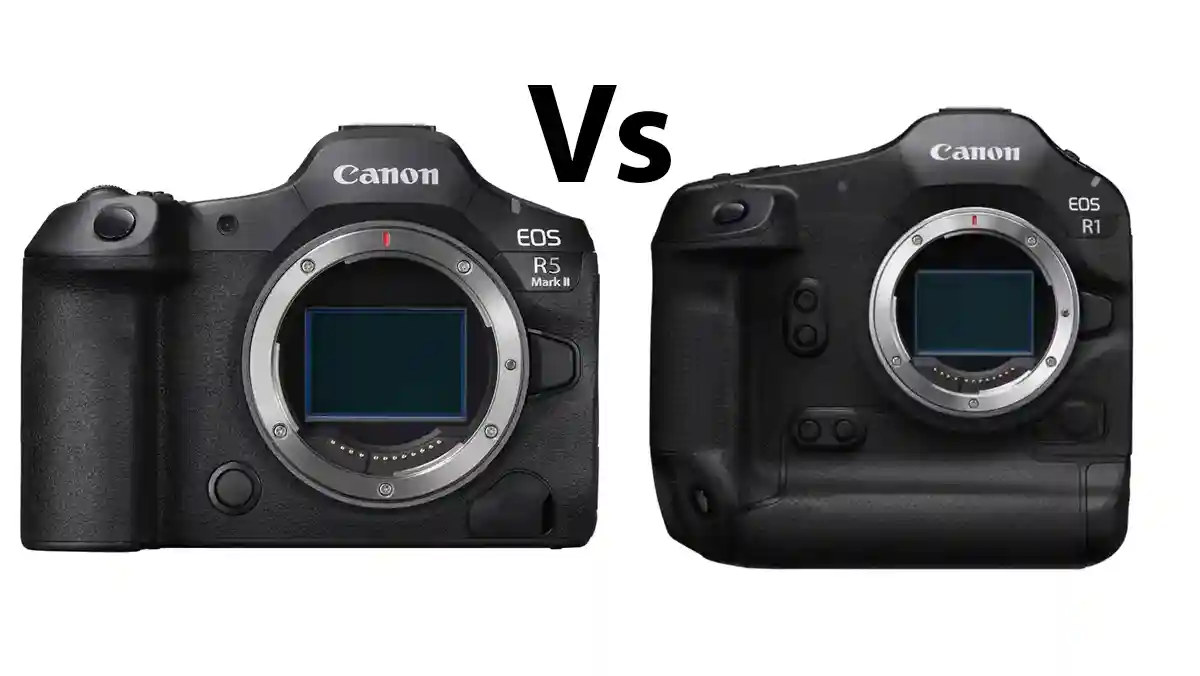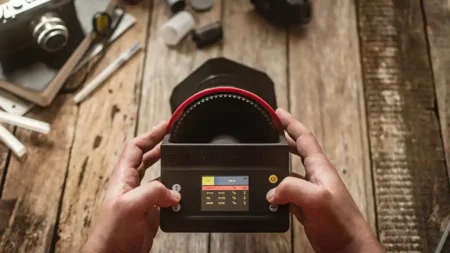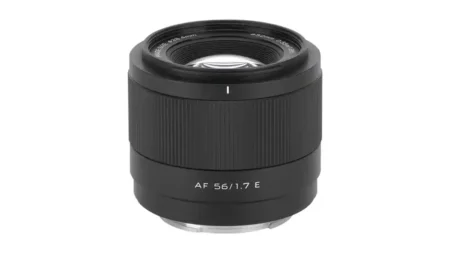Canon has consistently been at the forefront of digital photography innovation, and its latest flagship models, the EOS R1 and EOS R5 Mark II, push the boundaries even further. This detailed comparison explores the differences and enhancements between these two cameras, focusing on their physical build, sensor and processors, memory card slots, stills shooting rate, autofocus (AF) speed and modes, video capabilities, and price.
Physical Build, Weight, and Size
Canon EOS R1: The Canon EOS R1 is designed as the flagship model in the EOS R series, intended to meet the high demands of professional photographers. The body of the EOS R1 is slightly larger and heavier than the EOS R3, reflecting its enhanced durability and built-in vertical grip. The camera measures approximately 144 x 115 x 85 mm and weighs about 850 grams. This robust construction is designed to withstand tough conditions, making it ideal for sports, news, and wildlife photography.
Canon EOS R5 Mark II: The Canon EOS R5 Mark II maintains a compact and lightweight design similar to its predecessor but with minor adjustments for improved ergonomics and heat dissipation. It measures 139 x 98 x 89 mm and weighs around 750 grams. The magnesium alloy body offers excellent durability, and refined weather-sealing provides enhanced protection against dust and moisture, making it versatile for various shooting environments.
Sensor and Processors
Canon EOS R1: The EOS R1 features a new high-resolution CMOS sensor, though the exact resolution remains unconfirmed. It is paired with a dual processor system consisting of the new DIGIC Accelerator and the existing DIGIC X. This combination promises high-speed data processing, improved noise reduction, and superior image quality. The advanced processing capabilities are designed to support high-speed continuous shooting and sophisticated AF functions.
Canon EOS R5 Mark II: The EOS R5 Mark II is equipped with a 61MP back-illuminated CMOS sensor, significantly enhancing resolution and detail compared to the original EOS R5’s 45MP sensor. The camera also introduces a dual processor setup, combining the DIGIC X and the DIGIC Accelerator, which enhances data handling and processing speeds. This results in better noise reduction, faster readout speeds, and superior image quality, particularly in low-light conditions.
Memory Card Slots
Canon EOS R1: The EOS R1 features dual CFexpress Type B card slots, designed to meet the high data rate demands of its advanced video and still photography capabilities. This setup ensures fast write speeds and ample storage capacity, which are essential for 8K video recording and continuous burst shooting. The dual slots also offer redundancy, providing a backup in case of card failure.
Canon EOS R5 Mark II: Similarly, the EOS R5 Mark II is expected to feature dual CFexpress Type B card slots. This configuration supports the camera’s high-resolution sensor and advanced video recording capabilities, ensuring efficient data management and high-speed performance. The dual slots enhance reliability and workflow efficiency for professional photographers.
Stills Shooting Rate
Canon EOS R1: The EOS R1 excels in high-speed continuous shooting, offering up to 40 frames per second (fps) with its electronic shutter. This remarkable speed is supported by the advanced autofocus system, making it ideal for capturing fast-moving subjects in sports and wildlife photography. The high shooting rate ensures that photographers can capture critical moments with precision and clarity.
Canon EOS R5 Mark II: The EOS R5 Mark II also offers impressive continuous shooting capabilities, with a burst rate of 30 fps using the electronic shutter. The mechanical shutter maintains a rate of 12 fps, providing reliable performance for various shooting scenarios. The increased speed of the electronic shutter in the R5 Mark II ensures that photographers can capture more frames in quick succession without compromising on image quality.
Autofocus Speed and Modes
Canon EOS R1: The EOS R1 introduces an advanced AF system with high-speed, high-accuracy subject recognition, supported by deep learning technology. The system includes features like Action Priority, which enhances subject tracking by identifying and focusing on key players during fast-paced sports events. The AF system also includes improved eye, face, and animal tracking, ensuring precise focus in complex and dynamic shooting environments.
Canon EOS R5 Mark II: The EOS R5 Mark II features an enhanced version of the Dual Pixel CMOS AF II system, now with AI-driven improvements for better subject tracking. This system offers over 1,200 AF points and provides high-speed, high-accuracy recognition and tracking of animals, vehicles, and human faces and eyes. These enhancements ensure that photographers can maintain focus on their subjects seamlessly, even in challenging conditions
Video Capabilities
Canon EOS R1: The EOS R1 offers professional-grade video capabilities, including 8K video recording at 60fps and 4K video at 120fps. The camera also supports Full HD at 240fps for smooth slow-motion playback. Additionally, it includes 12-bit RAW recording, which provides high-quality video output with extensive post-production flexibility. The improved heat dissipation system allows for longer recording times without overheating.
Canon EOS R5 Mark II: The EOS R5 Mark II enhances its predecessor’s video capabilities by supporting 8K video recording at 60fps, 4K video at 120fps, and Full HD at 240fps. The 12-bit RAW recording feature allows for professional-grade video output, retaining more image data for greater flexibility in post-production editing. The improved heat management system in the R5 Mark II ensures reliable performance during extended video recording sessions.
Price
Canon EOS R1: The Canon EOS R1 is expected to be priced at a premium, reflecting its position as the flagship model in the EOS R series. While exact pricing has not been confirmed, estimates suggest it will be higher than the EOS R3, likely around $6,499 / £5,999 / €6,999. This pricing positions the R1 as a top-tier option for professional photographers who demand the highest performance and reliability.
Canon EOS R5 Mark II: The Canon EOS R5 Mark II is expected to be priced similarly to its predecessor, with slight adjustments for inflation and additional features. Estimated launch prices are around $4,199 / £4,499 / €4,999. This pricing reflects the camera’s advanced capabilities and positions it as a competitive option in the high-end market for professional photographers and videographers
Conclusion
In summary, the Canon EOS R1 and EOS R5 Mark II represent the pinnacle of Canon’s innovation in digital photography. The EOS R1, with its advanced sensor, dual processor system, and high-speed shooting capabilities, is designed for professionals who require top-tier performance and reliability. The EOS R5 Mark II builds on the success of its predecessor with significant enhancements in resolution, processing power, and video capabilities. Both cameras offer robust autofocus systems, improved heat management, and dual CFexpress card slots to meet the demands of professional use. While the EOS R1 is positioned as the ultimate flagship model, the EOS R5 Mark II provides a versatile and powerful option for those seeking cutting-edge technology and exceptional performance in their imaging equipment.



